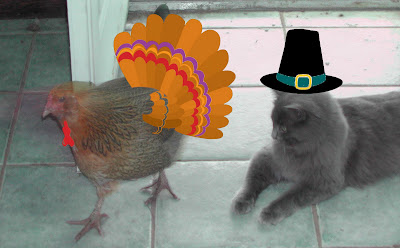
Shocked, I am sure you are SHOCKED to find that one of my favorite books of 2010 is a French cookbook. Well, every year there has to be a new French cookbook.
This year it is by Dorie Greenspan. Greenspan is one of those "foodies" that everyone seems to love. Her books are always informative and this one is no different. There is a lot of explanation, but in a friendly, "You can do it" kind of way. There are tips and ideas and lovely photos, so what more could one ask for.
Well, most of these recipes are culled from actual encounters Greenspan has had with people who actually cook. Then she has taken a cookbook writes mind to the recipes and the reader gets an actual French recipe with none of the hassle.
Here is a recipe that you might not think about at first glance. We have all seen pumpkins used as soup terrines, but here is a way to really use a pumpkin. (Remember to get a cooking pumpkin and not a big old Jack-O-Lantern pumpkin.)
Pumpkin Stuffed With Everything Good
1 pumpkin, about 3 pounds
Salt and freshly ground pepper
¼ pound stale bread, thinly sliced and cut into ½-inch chunks
¼ pound cheese, such as Gruyère, Emmenthal, cheddar, or a combination, cut into ½-inch chunks
2–4 garlic cloves (to taste), split, germ removed, and coarsely chopped
4 strips bacon, cooked until crisp, drained, and chopped
About ¼ cup snipped fresh chives or sliced scallions
1 tablespoon minced fresh thyme
About 1/3 cup heavy cream
Pinch of freshly grated nutmeg
Center a rack in the oven and preheat the oven to 350 degrees F. Line a baking sheet with a silicone baking mat or parchment, or find a Dutch oven with a diameter that’s just a tiny bit larger than your pumpkin. If you bake the pumpkin in a casserole, it will keep its shape, but it might stick to the casserole, so you’ll have to serve it from the pot — which is an appealingly homey way to serve it. If you bake it on a baking sheet, you can present it freestanding, but maneuvering a heavy stuffed pumpkin with a softened shell isn’t so easy. However, since I love the way the unencumbered pumpkin looks in the center of the table, I’ve always taken my chances with the baked-on-a-sheet method, and so far, I’ve been lucky.
Using a very sturdy knife--and caution--cut a cap out of the top of the pumpkin (think Halloween jack-o’-lantern). It’s easiest to work your knife around the top of the pumpkin at a 45-degree angle. You want to cut off enough of the top to make it easy for you to work inside the pumpkin. Clear away the seeds and strings from the cap and from inside the pumpkin. Season the inside of the pumpkin generously with salt and pepper, and put it on the baking sheet or in the pot.
Toss the bread, cheese, garlic, bacon, and herbs together in a bowl. Season with pepper--you probably have enough salt from the bacon and cheese, but taste to be sure--and pack the mix into the pumpkin. The pumpkin should be well filled--you might have a little too much filling, or you might need to add to it. Stir the cream with the nutmeg and some salt and pepper and pour it into the pumpkin. Again, you might have too much or too little--you don’t want the ingredients to swim in cream, but you do want them nicely moistened. (But it’s hard to go wrong here.)
Put the cap in place and bake the pumpkin for about 2 hours--check after 90 minutes--or until everything inside the pumpkin is bubbling and the flesh of the pumpkin is tender enough to be pierced easily with the tip of a knife. Because the pumpkin will have exuded liquid, I like to remove the cap during the last 20 minutes or so, so that the liquid can bake away and the top of the stuffing can brown a little.
When the pumpkin is ready, carefully, very carefully--it’s heavy, hot, and wobbly--bring it to the table or transfer it to a platter that you’ll bring to the table.











































